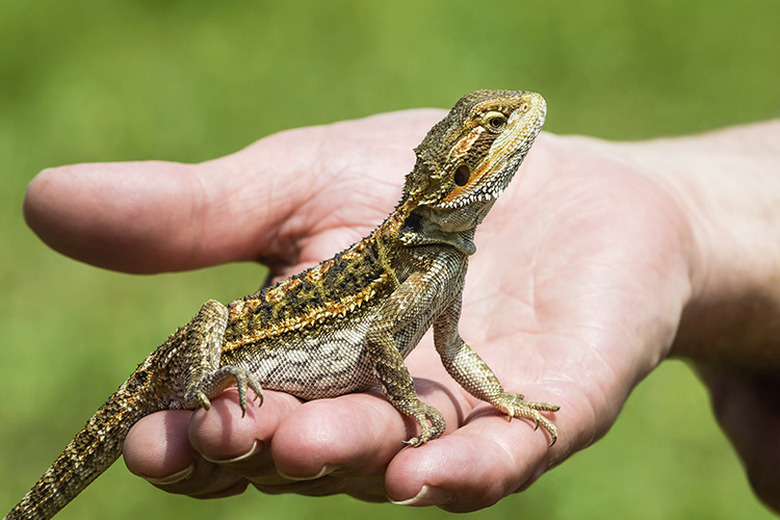What Are The Most Sociable Reptiles?
Ever think of a reptile as being a social animal? Just take a look at their evolutionary ancestor—the dinosaur. There were a multitude of dinosaurs that roamed the land, hunting and eating in herds or packs. But that's not all! Don't forget that the closest relative to the dinosaur is believed to be the bird (followed by the crocodile), and birds, which fall into a reptile sub-group, are very social animals.
So how social are reptiles themselves? It would seem that not many vertebrates are sociable (at least not to others of their kind.) Modern reptiles usually aren't found in groups and when they are, it is mostly due to sexual urges geared towards reproduction.This solitary nature can pose a problem for the pet owner who wants to own more than one reptile species, and housing more than one in the same area may lead to stressing the animal. Some lizards and snakes should never be housed together due to the risk of fighting (adult male iguanas are an excellent example.) As far as sociability goes, there are actually many reptiles that are social toward humans, snakes included! Here are a few of them:
The Bearded Dragon
The most sociable reptile it seems, is a lizard called the Bearded Dragon. Reportedly this friendly lizard makes a very good pet which really likes human interaction and attention. Oftentimes Bearded Dragons aren't compatible with other Bearded Dragons (which contrasts with the Gecko, next on our list, who appears to get along with others of their species) although the bearded dragon tolerates being handled without any problems.
Geckos
Geckos are an exception to the solitary rule. Housing a group of females with one male is a common practice, especially for breeding purposes. Take note however, it still stands to reason that housing more than one male in the same enclosure can lead to fighting. Still, geckos are not that aggressive and they tolerate handling well.
Turtles & Tortoises
Turtles can be housed together if they're the same size and not nipping each other. But more aggressive turtles like snapping turtles, mud turtles, musk turtles and soft-shell turtles should only be housed with turtles of similar size and species.
Tortoises and Box Turtles can usually be housed with similar turtles in groups, but use a very large cage. The most gentle are land turtles and tortoises which can be housed together without any problems because of their gentle nature. It is still advisable to observe these turtles for any negative signs and then take the appropriate action (just in case of negative interactions.)
The Argentine Tegus
This highly intelligent lizard is commonly known for seeking out human affection much like a dog or cat. This omnivorous reptile is the largest species among the tegus lizard. They're quite docile as adults and can even be housebroken! If well cared for, they can live for 15 to 20 years; if not cared for they can become very aggressive. Also important to mention is that if you have smaller pets in your household like a hamster or gerbil, it's advisable to keep them at a distance from this lizard. An Argentine Tegus cannot be trusted around small animals!
The Blue Tongue Skink
This lizard (with a 15 to 20 year lifespan) can grow from 18 to 24 inches. This is a good pet lizard for beginners because the skink has a great disposition and good personality. Although they may get on fine with humans, it's advisable to keep both juvenile and adult skinks in separate enclosures. It may be possible to keep two females or a male and a female together with close monitoring. If they fight they should be placed in separate cages. Males shouldn't ever be kept together.
The Ball Python
I'd have to say that the Ball Python is probably the most popular choice for a snake lover to make. They're a little shy but they handle captivity well, come in a large variety of colors and they are a small size (for a Python, that is.) They average 3 to 5 feet in size for the female and 2 to 3 feet for the male. They can live for 40 years or more, so get your will in order if you intend on owning one ( just in case.) It will take a while for you to establish a connection to your ball python because they're initially shy and untrusting. But when you establish that trust, they do seem to enjoy being handled. The best rule of thumb with a snake is, if it looks like it's going to strike, allow the snake some time to settle before picking it up.
The Corn Snake
This docile snake makes it a great choice for the first-time snake owner. They're easy to care for and they do not grow too large. Another beautifully colored snake, the corn snake is easy to handle and the same goes for its care. Corn snakes can grow up to about 3 to 6 feet and live for 15 to 20 years. Be careful with their housing because they are great 'Houdini' escape artists!
Of course, with most of the above mentioned reptiles, you should check with your local city, town or borough as to the legality of owning exotic pets in your specific area.
By Tom Matteo
References
Quora.com: What Are the Most Social Reptiles?
Pet Place: Can Reptiles Be Social?
Reptiles Magazine: Blue Tongue Skink/
Top 5: The Best Lizard Pets
Reptiles Magazine: Ball Python
About.com: Cornsnakes
About the Author
Tom Matteo has been a freelance writer since 1992. He specializes in hardware and software reviews for computers and gaming systems, and occasionally writes about such topics as animal behavior and care. Tom resides in Bethlehem, PA with his wife Tina and his beloved cockapoo, Angel.
